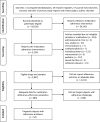Medication adherence interventions that target subjects with adherence problems: Systematic review and meta-analysis
- PMID: 26164400
- PMCID: PMC4679728
- DOI: 10.1016/j.sapharm.2015.06.001
Medication adherence interventions that target subjects with adherence problems: Systematic review and meta-analysis
Abstract
Background: Inadequate medication adherence is a pervasive, under-recognized cause of poor health outcomes. Many intervention trials designed to improve medication adherence have targeted adults with adherence problems. No previous reviews have synthesized the effectiveness of medication adherence interventions focused on subjects with medication adherence difficulties.
Objective: This systematic review and meta-analysis synthesized findings from medication adherence intervention studies conducted among adults with medication adherence difficulties.
Methods: Primary research studies were eligible for inclusion if they tested an intervention designed to increase medication adherence among adults with documented adherence difficulties and reported medication adherence behavior outcomes. Comprehensive search strategies of 13 computerized databases, author and ancestry searches, and hand searches of 57 journals were used to locate eligible primary research. Participant demographics, intervention characteristics, and methodological features were reliably coded from reports along with medication adherence outcomes. Effect sizes for outcomes were calculated as standardized mean differences, and random effects models were used to estimate overall mean effects. Exploratory dichotomous and continuous variable moderator analyses were employed to examine potential associations between medication adherence effect size and sample, intervention, and methodological characteristics.
Results: Data were extracted from 53 reports of studies involving 8243 individual primary study participants. The overall standardized mean difference effect size for treatment vs. control subjects was 0.301. For treatment pre- vs. post-intervention comparisons, the overall effect size was 0.533. Significantly larger effect sizes were associated with interventions incorporating prompts to take medications than interventions lacking medication prompts (0.497 vs. 0.234). Larger effect sizes were also found for interventions that linked medication taking with existing habits compared to interventions that did not (0.574 vs. 0.222). Effect sizes were largest among studies that measured adherence by pill counts or electronic event monitoring systems. Analysis of study design features identified several potential risks of bias. Statistically significant publication bias was detected, but adherence effect sizes were not significantly associated with other risks of bias.
Conclusions: These findings document that interventions targeting individuals with medication adherence problems can have modest but significant effects on medication-taking behavior. The findings support the use of behavioral strategies such as prompts and linking medications to habits to increase medication adherence in adults with adherence challenges. Face-to-face interventions appear to be critical for patients who have experienced past problems with medication adherence.
Keywords: Intervention; Medication adherence; Meta-analysis; Systematic review.
Copyright © 2016 Elsevier Inc. All rights reserved.
Conflict of interest statement
Figures
References
-
- DiMatteo MR, Giordani PJ, Lepper HS, Croghan TW. Patient adherence and medical treatment outcomes: a meta-analysis. Med Care. 2002;40:794–811. - PubMed
-
- Christiansen AJ. Patient Adherence to Medical Treatment Regimens: Bridging the Gap Between Behavioral Science and Biomedicine. New York, NY: Yale University Press; 2004.
-
- Bosworth HB. Medication treatment adherence. In: Bosworth HB, Oddone EZ, Weinberger M, editors. Patient Treatment Adherence: Concepts, Interventions, and Measurement. New York, NY: Psychology Press; 2006. pp. 147–194.
-
- Chaudhry HJ, McDermott B. Recognizing and improving patient nonadherence to statin therapy. Curr Atheroscler Rep. 2008;10:19–24. - PubMed
Publication types
MeSH terms
Grants and funding
LinkOut - more resources
Full Text Sources
Other Literature Sources
Medical
Miscellaneous


